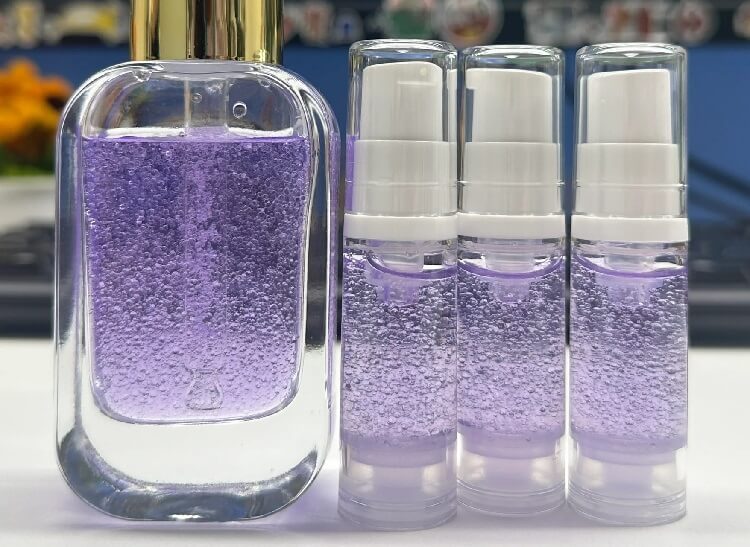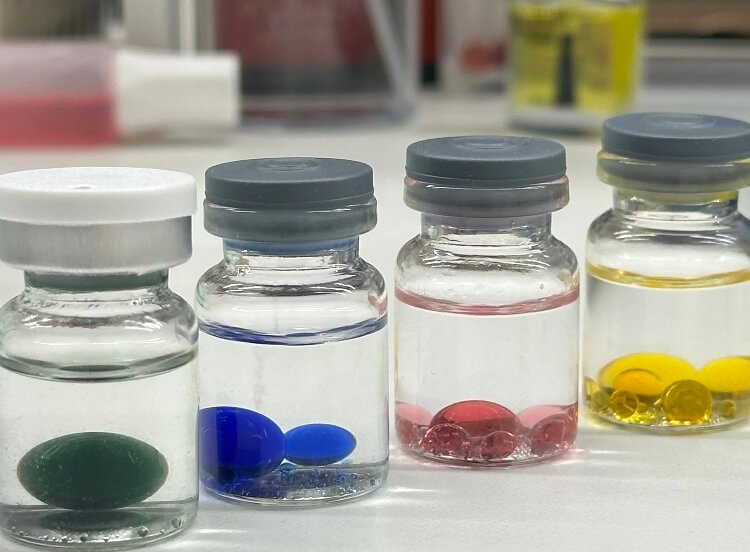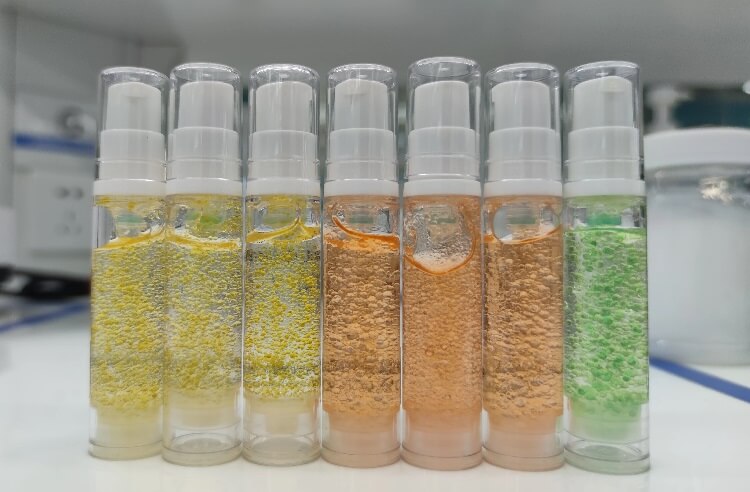
In skincare, microcapsules technology is revolutionizing delivery. It encases actives, boosting penetration, stability, and efficacy—ushering in precise, enhanced skincare.

In skincare, Microcapsules technology uses specialized liposomes to Microcapsules various active ingredients into microparticles. These Microcapsulesare significantly smaller than those in traditional skincare products, allowing them to efficiently penetrate directly into the skin's basal layer and dermis, leaving the skin instantly moisturized, plump, and revitalized.
Think of it this way: it's like tiny carts carrying skincare nutrients traveling through the skin's surface, delivering them to where they're needed. These nutrients are instantly absorbed by the skin, resulting in enhanced skincare effectiveness.
This technology, by encapsulating active essences with specialized liposomes, transforms large and small molecules of nutrients into Microcapsules, much smaller than those in ordinary cosmetics. TheseMicrocapsules penetrate the skin's surface, dermis, and subcutaneous tissue in a matter of seconds. This allows the skin to fully absorb nutrients, nourishing it from the inside out. It also reduces the greasy feeling caused by nutrients remaining on the skin's surface, and reduces the risk of clogged pores, oil particles, and acne.
For example, Helena Rubinstein Dew Drops are very popular in the market. The unique water-in-oil dew drop texture, easy absorption, and deep hydrating effect are actually due to the micro-encapsulation technology!

Researchers have discovered that the structure of microcapsules, similar to cell membranes, can fuse with skin cells, making them more flexible and enabling active ingredients to penetrate the skin barrier faster and reach deeper layers.
Microencapsulation technology protects active ingredients from air, moisture, and UV rays, thereby prolonging their effectiveness.
Research has shown that after injecting active ingredients deep into the skin, microcapsules slowly release them over time, ensuring longer-lasting effectiveness.
Dermatologists point out that microcapsules can encapsulate potentially irritating ingredients, reducing discomfort while allowing these ingredients to penetrate deeper into the skin's surface.
In the development of creams and creams, we microencapsulate ingredients such as oils and waxes. Microencapsulated ingredients disperse more evenly throughout the formula, eliminating the clumping of oils or waxes that can occur in traditional formulas. This results in a finer, more uniform texture, smoother application, and significantly reduced graininess, naturally enhancing the user experience.
If you want to adjust the consistency of a cream, you can also use microcapsules. For example, you can control the size and quantity of the microcapsules, as well as the properties of the wall material. For example, choose a wall material with specific rheological properties. When dispersed within the cream, the microcapsules enhance the cream's cohesion and viscosity. This makes the cream easier to form and apply, while maintaining the right softness—neither too thin to spread nor too thick to be usable.
Encapsulating fragrance within microcapsules prevents it from being destroyed by light and heat in the air, and prevents it from dissipating quickly. Perfumes sprayed on the body use special microcapsules, and body heat slowly releases the middle and base notes, as Dior's "J'adore" does.
Companies like Fechii use technology to encapsulate fragrance within microcapsules, allowing the scent to linger for more than six times longer than before. Even better, by using several layers of microcapsules to encapsulate different fragrances, the scent changes layer by layer as you use it, creating a truly fascinating experience.
Blocking light and protecting ingredients: Microcapsules act like a protective shell, effectively blocking light (especially UV rays) and protecting the active ingredients within (such as sunscreen) from degradation. This not only ensures the efficacy of the ingredients but also reduces product deterioration due to light exposure, reducing the need for preservatives.
Stabilizing systems and preventing separation: In products like lotions and creams, microcapsules act as a physical barrier, stabilizing the oil-water mixture and preventing separation. This maintains a uniform and stable product texture, reducing the chances of microbial growth due to delamination or structural damage, and thus reducing the amount of preservatives added.
Intrinsically antimicrobial or environmentally regulated: Some microcapsule wall materials have inherent antimicrobial properties. Furthermore, microcapsules can inhibit microbial growth by modifying the surrounding microenvironment (for example, by disrupting microbial cell membranes through electrical charge, controlling the local pH, or reducing water activity). These mechanisms provide additional protection, further reducing reliance on traditional chemical preservatives.
Microencapsulation technology utilizes natural polymers such as chitosan and sodium alginate. These materials are highly biodegradable and can be completely broken down by microorganisms, eliminating the long-term environmental pollution associated with traditional chemical materials. More importantly, this technology securely locks in the active ingredients, releasing them precisely when needed, extending their protection and significantly increasing their availability.

Microencapsulation technology is changing how skincare works, and its innovative uses are making products better in several key ways.
Traditional ones lose their hydrating power not long after you put them on. But here’s where microencapsulation steps in: skincare developers trap ingredients like hyaluronic acid and glycerin inside tiny capsules. These capsules settle on your skin, forming a thin protective layer that lets the moisture seep out slowly over time—so your skin stays hydrated much longer.
Whitening products get a boost from this technology too. Vitamin C and niacinamide are great for lightening skin, but they’re fragile—heat, light, or air can break them down fast. Formulation experts found that wrapping these ingredients in microcapsules keeps them stable. Even better, the capsules deliver the whitening ingredients right to areas where melanin (the pigment that darkens skin) forms, making them more effective without bothering the rest of your skin.
When it comes to fighting wrinkles, microencapsulation helps there as well. Collagen and peptides are essential for plumping skin and reducing lines, but they need to reach deep into the skin to work. By enclosing them in microcapsules, these ingredients can sink into the skin’s layers. Once there, the capsules release their contents gradually, prompting the skin to make more collagen, firming it up and softening wrinkles over time.
Sunscreen benefits too. We all know UV rays damage skin, but regular sunscreen ingredients don’t hold up well—after hours in the sun, they break down, and their protection fades. Microencapsulation fixes that: tucking sunscreen ingredients into these tiny capsules keeps them stable, so the sunscreen stays effective longer, shielding your skin better.
It even makes skincare nicer to use. Some ingredients have strong smells or can irritate skin when they touch it directly. But when these are sealed in microcapsules, they don’t cause that discomfort. The result? Products feel gentler, more pleasant to apply, without sacrificing their benefits.

Looking down the road, microencapsulation technology is letting cosmetics take on all sorts of new forms. Think sprays, face masks, serums—all with tiny encapsulated ingredients. This isn’t just adding more products to the shelf; it’s drawing in people who want something fresh. And the possibilities keep growing.
Take sports cosmetics, for instance. Athletes need products that hold up through sweat and stay put, and that keep a fresh smell even after a hard workout. Microencapsulation can make that happen. Then there’s medical aesthetics—researchers are mixing this tech with medicines or active ingredients to create products that don’t just nourish skin, but actually help repair it or ease issues.
What’s really making this technology a standout for cosmetics? It lets brands control exactly when ingredients are released, keeps those ingredients from breaking down too fast, and makes using the products a nicer experience. It fixes the old headaches—like ingredients fizzling out before they work, or products irritating skin—and at the same time, lets brands make formulas that work better and are easier on the environment. As we learn more about materials and biotech, you can bet we’ll find even more ways to use it. The future for this tech in cosmetics? It’s only going to get more interesting.

XIRAN Cosmetics knows its way around the latest tech—and it’s got the R&D and production chops to back that up. This cosmetics maker has taken nano-microencapsulation technology and put it to work in several of its clients’ biggest products, and the results? They’ve been killing it in the market.
We just teamed up with a new, innovative skincare brand to create a microencapsulated serum—one that “penetrates instantly and repairs deeply.” The client really cared about three things: getting those super-active ingredients where they need to go without breaking down, making the serum feel great the second you put it on, and keeping skin nourished for hours. So our Xiran team leaned on what we know about microencapsulation to make it happen.
The client picked some repair ingredients that work really well but are tricky to keep stable—things like certain peptide mixes and natural antioxidants. We made a custom liposome encapsulation method just for these. Using nanoencapsulation, we wrapped them up tight, so they stay active when we’re making the serum and while it’s sitting on the shelf. Then, once it touches your skin, they release fast—right where they need to go.
We tweaked the microcapsules—made their size super tiny (nanoscale) and adjusted the outer layer—so the serum absorbs way better through the skin. That’s how we got that “put it on, and it’s already absorbed” feel the client wanted. Plus, because the ingredients release slowly, you don’t get that irritation that can happen when a bunch of strong stuff hits your skin all at once. And unlike old serums that leave your skin sticky or greasy, this one feels light and silky.
We pulled off a one-of-a-kind serum formula—a stable “oil-in-water active microcapsule” system. It’s a bit like the Helena Dewdrop technology you might have heard of, but we tweaked it to work with these specific ingredients. Our Xiran facilities are GMP-certified, top-notch, and we keep a tight handle on production. That means when we make big batches, most of the microcapsules stay intact (hardly any break), and every batch comes out just like the last one.
We start by helping pick the right active ingredients, check if microencapsulation will work, tweak the formula, test how stable it is (even when it’s in bright light or hot temperatures). Then we make big batches, fill the bottles, and package everything up. Xiran does all that ODM/OEM stuff in one go, so we can answer the client’s needs fast and get the product out there quicker.
Once it launched, the “Instant Revitalizing Essence” took off. People loved how fast it absorbs and how it keeps skin feeling refreshed for so long. It became a top seller on the brand’s Tmall store, moving over 10,000 bottles a month. Beauty bloggers and regular users alike raved about it—how quick it soaks in, how nice it feels, and how the effects stick around. It just goes to show: Xiran knows how to use microencapsulation technology, and we can turn that fancy science into products people actually buy and love.

We’ve been working with microencapsulation tech for a while—know how to make it stick, whether it’s liposomes or polymer microspheres. Need something tailored to a specific ingredient or a particular effect? We can tweak it to fit.
Our R&D crew’s got a knack for this, too. They’re good at mixing that microencapsulation tech with the right formulas, making sure the whole product works better—more stable, more effective, no fumbling.
And when it comes to making stuff? We’ve got the tools and the checks to back it up. Specialized gear, strict quality looks—means the microencapsulated products we turn out are solid: consistent, steady, and easy to make more of when you need it.
Plus, we handle the whole shebang. From brainstorming the first idea, to nailing down the formula, tracking down the right ingredients, making the product, packaging it up, even getting it shipped—we take care of every step. Cuts down on headaches and gets your product out there faster.
At Xiran Cosmetics, we want to be the partner brands can lean on when they’re diving into new tech like this. We’re here to team up, make skincare that works better, feels better, and stands out in the market. If you’re as fired up about this tech as we are, let’s link up—turn that potential into the next big thing.

